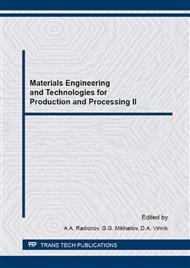[1]
I.I. Tsypin, White Wear-Resistant Cast Irons: Structure and Properties, Metallurgiya Publ., Moscow, 1983. (in Russ. ).
Google Scholar
[2]
A.A. Zhukov, G.I. Sil'man, M.S. Frol'tsov, Wear-Resistant Castings of Complex Alloy White Cast Irons, Mashinostroenie Publ., Moscow, 1984. (in Russ. ).
Google Scholar
[3]
D.A. Mirzaev, N.M. Mirzaeva, A.N. Emelyushin, Ledeburite alloys for tools for machining of graphite, Metal Science and Heat Treatment. 30 (1988) 519-523. DOI: 10. 1007/BF00777442.
DOI: 10.1007/bf00777442
Google Scholar
[4]
A.N. Emelyushin, D.A. Mirzaev, N.M. Mirzaeva, E.V. Petrochenko, N.V. Koptseva, Metal Science, Physics and Mechanics Applied to Working of Graphitized Materials, Structure and Wear Resistance of Tools, MGTU Publ., Magnitogorsk, 2002. (in Russ. ).
Google Scholar
[5]
A.N. Emelyushin, D.A. Mirzaev, N.M. Mirzaeva, E.V. Petrochenko, K. Yu. Okishev, O.S. Molochkova, Cast Tools of Chromium Cast Irons, Structure and Properties, MGTU Publ., Magnitogorsk, 2016. (in Russ. ).
Google Scholar
[6]
Yu.A. Geller, Tool Steels, Metallurgiya Publ., Moscow, 1983. (in Russ. ).
Google Scholar
[7]
G. Krauss, Steels: Heat Treatment and Processing Principles, ASM International, (1990).
Google Scholar
[8]
K. Yu. Okishev, A.S. Sozykina, Structure and hardness changes with hardening temperature in high-chromium steels and cast irons, Bull. of the South Ural State Univ. Ser. Metallurgy. 16 (2011) 67-70. (in Russ. ).
Google Scholar
[9]
Yu.D. Koryagin, K. Yu. Okishev, A.S. Sozykina, Optimization of chemical composition and heat treatment of high-carbon iron alloys with 14 % chromium and 3 % vanadium, in: Proceeding of Materials Science Forum. 843 (2016).
DOI: 10.4028/www.scientific.net/msf.843.111
Google Scholar
[10]
C. Zener, Kinetics of the decomposition of austenite, Trans. AIME. 167 (1946) 550-583.
Google Scholar
[11]
M. Hillert, Solid state phase transformations, Jernkontoret Annaler. 141 (1957) 757-790.
Google Scholar
[12]
C. Wert, C. Zener, Interference of growing spherical precipitate particles, J. Appl. Phys. 21 (1950) 5-8. DOI: 10. 1063/1. 1699422.
DOI: 10.1063/1.1699422
Google Scholar
[13]
J.W. Christian, The Theory of Transformations in Metals and Alloys, Pt. I. Elsevier Sci. Ltd., 2002. DOI: 10. 1016/B978-008044019-4/50016-7.
Google Scholar
[14]
B. -J. Lee, On the stability of Cr carbides, CALPHAD. 16 (1992) 121-149. DOI: 10. 1016/0364-5916(92)90002-F.
DOI: 10.1016/0364-5916(92)90002-f
Google Scholar
[15]
A.W. Bowen, G.M. Leak, Solute diffusion in alpha- and gamma-iron, Metallurgical Transactions. 1 (1970) 1695-1700. DOI: 10. 1007/BF02642019.
DOI: 10.1007/bf02642019
Google Scholar
[16]
P.L. Gruzin, Diffusion of cobalt, chromium and tungsten in iron and steel, Doklady AN SSSR. 94 (1954) 681-684. (in Russ. ).
Google Scholar
[17]
S. Gertsriken, I. Dekhtyar, Investigation of chromium diffusion in iron-chromium alloys with impurities, Zhurnal Tekhnicheskoy Fiziki. 20 (1950) 1005-1014. (in Russ. ).
Google Scholar
[18]
K. Nakazawa, Effect of austenitic state on the Ms point of hypereutectoid alloy steel, J. Japan Inst. Metals and Materials. 27 (1963) 245-250.
DOI: 10.2320/jinstmet1952.27.6_245
Google Scholar
[19]
M. Hansen, K. Anderko, Constitution of Binary Alloys, McGraw-Hill Book Co., (1958).
Google Scholar
[20]
F. Maratray, R. Usseglio-Nanot, Atlas: transformation curves White iron chromium and chromium-molybdenum, Climax Molybdenum S.A., Paris, (1970).
Google Scholar
[21]
D.A. Mirzaev, Yu.D. Koryagin, A.A. Kulikov, A.S. Sozykina, Heat Treatment of Castings from White Wear-Resistant Cast Iron, Bull. of the South Ural State Univ. Ser. Metallurgy. 13 (2013) 111-115.
Google Scholar
[22]
Ya.R. Rauzin, Heat Treatment of Chromium Steel, Mashinostroenie Publ., Moscow, 1978. (in Russ. ).
Google Scholar
[23]
V.S. Popov, N.N. Brykov, N.S. Dmitrichenko, P.G. Pristupa, Durability of Refractory Brick Production Equipment, Metallurgiya Publ., Moscow, 1978. (in Russ. ).
Google Scholar


